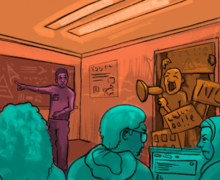ArtRage photography exhibition will depict lives of refugee population in Syracuse
Courtesy of Maranie R. Staab
Maranie R. Staab wanted to better understand the refugee community in Syracuse and get to know people who resettled in the city through her photography.
From Sept. 14 to Oct. 26, people can get a glimpse into the lives of the Northside refugee community through Staab’s ArtRage Gallery exhibition, “RECREATING HOME: Photographs of the Refugee Experience.” Staab is currently a second-year graduate student in the multimedia, photography and design program in the S.I. Newhouse School of Public Communications at Syracuse University.
ArtRage centers its exhibitions around social justice and environmental issues, said Kimberley McCoy, community engagement organizer for the gallery. She said their mission is to create exhibitions that get people to think about critical issues and take action in the community.
McCoy said “RECREATING HOME” focuses on how some natural-born American citizens may not realize the challenges that refugees go through — why they have to flee, what many go through in refugee camps and what it’s like having to start over.
“I’ve always been drawn to social issues and human rights issues,” Staab said. “At a certain point, these things intersected with photography. That passion for photography dovetails with what I think is important to talk about.”
The upcoming exhibition will consist of 30 black and white photographs that focus on the personal and professional lives of refugees. In addition to the photos in Syracuse, there will be a running slideshow on a television of Staab’s international work, as she’s used photography to document the lives of refugees all over the world, she said.
In the last few years, Staab has worked in the Middle East and Africa, specifically with displaced populations, she said. Staab said human displacement is a natural interest of hers and is one of the biggest issues in the world right now.
Human displacement can refer to internally displaced people, those who are forced to flee their homes but remain within their country’s borders, Staab said. It also refers to refugees who flee their countries due to issues such as war, poverty, natural disasters or persecution.
Last summer Staab moved to Syracuse to start in the graduate program at Newhouse and immediately reached out to organizations that work with refugees.
One of the organizations she worked with is Hopeprint, a community advocacy group that aims to unify diverse communities, said Nicole Watts, founder and executive director of the organization. Watts said Hopeprint creates spaces where people can ultimately be empowered to live to their full potential.
“One of the things that I think everyone appreciated about Maranie was that she kept showing up and really honored them in the photographs, gave them copies of the pictures and really treated them with dignity,” Watts said.
Watts said Staab was different from other photojournalists because she treated each refugee as someone who had a story they were sharing, as opposed to taking their story from them.
Staab said it’s always a privilege to be allowed in someone else’s life because it gives her the opportunity to learn about experiences that differ from her own.
“I learned from having conversations with people that had experiences and have overcome things that I myself never will,” Staab said.
In the last 15 years, nearly 15,000 refugees have settled in Syracuse, according to ArtRage’s website. McCoy said they wake up every morning to face the challenge of starting from scratch, but they wake up with gratitude and hope for their new lives.
Staab said that she wants to keep working with people of different backgrounds. She said that if anyone is interested in sharing their story of coming to Syracuse as a new resident to the country, then they should reach out to her.
“We are living in a politically tense time,” Staab said, “and by sharing photos and stories, there is a hope that we can relate to people we initially never thought we could relate to.”
Published on September 3, 2019 at 10:08 pm





